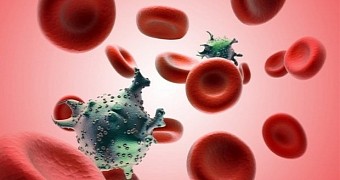A new study authored by scientists at the Gladstone Institutes and published in the journal Cell Reports earlier this week argues that it is not HIV that causes AIDS, at least not directly.
Rather, the researchers say the body's own immune cells are the ones that eventually trigger the disease. This means that tampering with them might help prevent the onset of AIDS.
How HIV affects the body
HIV, i.e. the Human Immunodeficiency Virus, can be transmitted via unprotected intimate relations, contaminated blood transfusions or hypodermic needles, or from mother to child during pregnancy, birth and breastfeeding.
Once in the body, the virus works to weaken the immune system. Infected individuals develop AIDS, i.e. Acquired Immune Deficiency Syndrome, when their immune system is seriously damaged.
More precisely, a patient is diagnosed with AIDS when their count of CD4 cells, which are specialized cells of the immune system, drops below 200 per milliliter of blood. The CD4 count in healthy individuals is 500 to 1,500.
In their study in the journal Cell Reports, the Gladstone Institutes scientists explain that, having carried out a series of experiments, they found that HIV progresses to AIDS via cell-to-cell transmission.
First, the virus infects a few cells. Then, these infected cells try pass on HIV to healthy cells, which respond by committing suicide in self-defense. It is when enough immune cells die in this manner than the infection progresses to AIDS.
The Gladstone Institutes researchers say that, when compared to having the free-floating virus itself infect new cells, this cell-to-cell transmission is about 100 to 1,000 times more effective.
So much so that as much as 95% of cell death linked to HIV is the result of cell-to-cell transmission rather than having the self-standing virus infect healthy cells, the specialists go on to detail.
“Although free-floating viruses establish the initial infection, it is the subsequent cell-to-cell spread of HIV that causes massive CD4 T cell death,” says researcher Nicole Galloway.
“The fundamental 'killing units' of CD4 T cells in lymphoid tissues are other infected cells, not the free virus. And cell-to-cell transmission of HIV is required for activation of the main HIV death pathway,” adds scientist Gilad Doitsh.
The importance of this study
As noted, being infected with HIV does not necessarily mean having AIDS. On the contrary, it takes time for the infection to affect the body's immune system to such an extent that the patient moves on to develop the disease.
Now that they know it's cell-to-cell transmission that facilitates the progression from HIV infection to AIDS, the Gladstone Institutes researchers are considering toying with this pathway to see if they can prevent the onset of the disease.
“By preventing cell-to-cell transmission, we may able to block the death pathway and stop the progression from HIV infection to AIDS,” explains specialist Warner C. Greene.
True, people would still be HIV positive and would still be able to infect others, but their immune system would not be compromised and so they would not become vulnerable to all sorts of conditions AIDS patients usually face.

 14 DAY TRIAL //
14 DAY TRIAL //